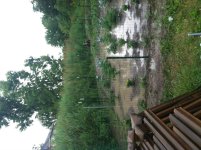City Farmer
Platinum Member
- Joined
- Jan 3, 2013
- Messages
- 527
- Location
- Chesterfield, Mi
- Tractor
- Ford 3000, 4400 & 4500TLB Case 830 Case 350 dozer
I need a little help on the best way to drain my (40'x80') garden of excess rain water. I've had the garden 5 years, the first 2 were great, so many vegetables I couldn't give them away fast enough. One was ok but the last 2 were a total loss. I have a rain water drainage creek at one end of my garden. My brother told me to put some 4" socked perforated under the garden but I'm concerned about running it over with the tiller in the spring when the ground is wet. Is it better to mound the rows or put some sort of drainage? I can pretty much do whatever needs to be done. I've got a Ford 3000 & 4400 with a BH, 60" tiller, 60" box scraper, middle buster, back blade, PHD, 2 bottom plow and a small set of disc's. If I need another tool to get the job done I'll buy it, I just want it fixed once and for all. One last question, I have access to all the free horse manure I want, is it to late to add it to the garden for this season? We're about 2.5 months before I'll plant. Thanks in advance. Here is a picture of what I'm working with, the creek is at the left of the picture hidden by the Phragmites that have taken over everywhere around here these last 10yrs.
